Trade in Services: The Most Dynamic Segment of International TradeThe World Trade Organization (WTO) marks its 20th anniversary with a series of brochures to assist understanding of specific WTO agreements. This publication focuses on the WTO General Agreement on Trade in Services (GATS), which provides the legal ground rules for international trade in services, allowing WTO members the flexibility to open their markets to foreign competition to the extent of their choosing. GATS entered into force in 1995 and remains the only set of multilateral rules covering international trade in services. This brochures provides an overview of the different modes by which services are traded, commitments taken by WTO members, and developments enhancing GATS commitments and information on trade in services. Author: World Trade Organization Year: 2015 Download Tags: Services, Trade Facilitation, Economic Growth, WTO Technical Barriers to Trade: Reducing Trade Friction from Standards and RegulationsThe World Trade Organization (WTO) marks its 20th anniversary with a series of brochures to assist understanding of specific WTO agreements. This publication provides an overview of the WTO Agreement on Technical Barriers to Trade (TBT), which aims to ensure that technical regulations, standards, and conformity assessment procedures are non-discriminatory and do not create unnecessary obstacles to trade. It reviews how the TBT Committee, a unique multilateral forum for the discussion of standards and regulations affecting trade comprising WTO members, have created a predictable trading environment by enacting transparency provisions, and facilitated trade by encouraging WTO members to base their measures on international standards. Author: World Trade Organization Year: 2015 Download Tags: Technical Barriers to Trade, Trade, Trade Facilitation, WTO Sri Lanka Energy Sector Development Plan For A Knowledge-Based Economy, 2015-2025Sri Lanka has set an set an ambitious goal of 100% energy self-sufficiency by 2030. With annual total electricity demand estimated at 10,500 gigawatt hours—increasing annually by around 4-6%—and challenges including high cost of electricity, 100% dependence on imported oil for the transport sector, and need for large investments in infrastructure, this book unveils how the energy sector plans to achieve energy security in the next 10 years—envisioning a future where clean, reliable, affordable energy is made available 24/7 to the whole country. This sector development plan for a knowledge-based economy aims to provide a balance between the country's energy demand and supply, and its long-term perspective anchored on continuous economic growth, through renewable and indigenous sources of energy. Author: Sri Lanka Ministry of Power and Energy Year: 2015 Download Tags: Energy, Sri Lanka, Renewables 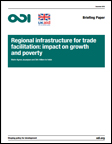 Regional Infrastructure for Trade Facilitation: Impact on Growth and Poverty Reduction - Policy SummaryThis research aims to provide evidence on the effects of regional infrastructure and associated trade cost reduction on growth and poverty reduction of economic actors, including households and firms, around the border. Data shows that investment in regional integration for trade facilitation (RITF) promotes economic activity, supports activity of informal traders, and facilitates integration into global value chains and international production networks. The report highlights that new hard infrastructure benefits economic actors more when complementary regulations that allow for efficient trade logistic services are also put in place. It recommends that policymakers account for the impact of RITF on reducing constraints to connectivity in their evaluations and policy decisions. Author: Marie-Agnes Jouanjean and Dirk Willem te Velde Year: 2015 Download Tags: Trade Facilitation, Global Value Chains, Poverty Reduction World Energy Outlook 2015Global energy is undergoing major changes. Renewables are increasingly contributing to the the world’s power generation capacity, and coverage of mandatory energy efficiency regulation worldwide has expanded to more than a quarter of global consumption. This World Energy Outlook 2015 provides insights to policy-makers, industry and other stakeholders on the state of the energy sector today, discussing which changes are transient or cyclical, the risks and opportunities that may lie ahead, and actions that can put the energy system on a more secure and sustainable footing. It also includes a special chapter discussing India’s energy outlook, and how development in India's energy sector over the coming decades will impact the country and the global energy system as a whole. Author: International Energy Agency Year: 2015 Download Tags: Energy, India, Renewables Sri Lanka: Building on SuccessOver the years, the Asian Development Bank (ADB) and its many partners in Sri Lanka have worked together to realize the goal of changing the country’s status from low to middle income. With Sri Lanka moving toward becoming an upper middle-income country in a few years, challenges lie on the road ahead. This publication provides an overview of recent ADB support toward Sri Lanka's development in diverse areas including transport, energy and education, and discusses how the Government of Sri Lanka and ADB will transition their partnership to push the country to the next level of prosperity. Author: Asian Development Bank Year: 2015 Download Tags: Sri Lanka, Transport, Ports, Development, Economic Growth Disentangling Transit Costs and Time in South AsiaLandlocked least developed countries are often hugely disadvantaged from a lack of effective transit options, which raise transportation costs and decrease their effective participation in international trade. This study examines trade barriers that impede the trade flow of Bhutan and Nepal through India's gateway ports of Haldia and Kolkata, under the overarching research theme of the impact of regional infrastructure for trade facilitation on growth and poverty reduction. It analyzes the impact of transit regulations and agreements on the cost of services required to transit goods between the ports and Bhutan or Nepal, to identify how the two landlocked countries are affected by the cost of transit services, which trade costs vary most significantly, and how firms are affected by the cost of transit services. Author: Prabir De, editor Year: 2015 Download Tags: Trade Facilitation, Transport Facilitation, Bhutan, Nepal Policy Brief: A Safe Public Transportation Environment for Women and GirlsEnsuring safe public transport for women enhances inclusive growth by encouraging their participation in the public sphere, including the workforce. A range of interventions dealing with the issue of sexual harassment—which negatively impacts women's movement in public spaces, affecting their productivity—in public transportation have been adopted by governments and civil society around the world, including media campaigns, targeted mobile applications, and women-only public vehicles. This report draws on rapid assessments of sexual harassment in public transportation conducted in three countries in Asia, with recommended actions to prevent and address sexual harassment in public transportation and its related spaces, such as train platforms and bus stops. Author: Asian Development Bank Year: 2015 Download Tags: Gender, Inclusive Growth, Transport 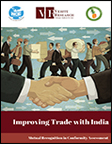 Improving Trade with India: Mutual Recognition in Conformity AssessmentThis study examines the current status of Sri Lankan exports to India, focusing on non-tariff barriers (NTBs) existing between India and Sri Lanka, including conformity assessment procedures applied in the two countries. Providing a comprehensive analysis of issues related to standards and regulations faced by processed food exporters from Sri Lanka to India, the study highlights how India's non-recognition of testing and certification conducted outside its borders forms a significant barrier, one that is critical to the performance of Sri Lanka's exports to India. It proposes that the most workable solution is to implement a Mutual Recognition Agreement, which will allow recognized, competent and accredited conforming assessment bodies from India and Sri Lanka to accept certificates of conformity, letting Sri Lankan exporters take advantage of duty concessions offered by the India-Sri Lanka Free Trade Agreement. Author: Verité Research Year: 2015 Download Tags: India, Sri Lanka, Trade, Harmonisation 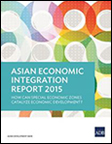 Asian Economic Integration Report 2015: How Can Special Economic Zones Catalyze Economic Development?The 2015 Asian Economic Integration Report reviews regional economic cooperation and integration in Asia, providing updates on recent developments affecting trade policy, including the conclusion of Trans-Pacific Partnership, relatively large number of proposed FTAs--with India among the major proponents, and progress of trade facilitation in Asia through the World Trade Organization's Trade Facilitation Agreement. Trade facilitation in developing Asia has significantly advanced over the last several decades, with a total of 48,000 kilometers of regional transport corridors along major supply chains improved. From 1992 to 2014, developing Asia together with ADB and its partners have mobilized $38.4 billion for 186 regional transport and trade facilitation investment projects under three subregional programs—including the South Asia Subregional Economic Cooperation (SASEC) program. This also issue includes a special chapter highlighting how special economic zones can catalyze economic development, with the right business environment and policies in place. Author: Asian Development Bank Year: 2015 Download Tags: Special Economic Zones, Trade Facilitation, Transport 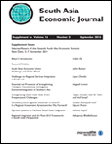 South Asia Economic Journal: Supplement Issue: Papers of the Seventh South Asia Economic SummitThis special issue of the South Asia Economic Journal contains papers presented at the 7th South Asia Economic Summit. With South Asia moving toward a South Asia Economic Union (SAEU), several major challenges remain, including reduction in the sensitive list, removal of Non-Tariff Barriers, effective and faster implementation of the South Asian Agreement on Trade in Services, effective regional investment cooperation, promotion of trade facilitation measures, promotion of regional value chains, cross-border energy cooperation. The articles in this volume tackle these critical issues to develop a way forward and generate ideas on policy priorities. A paper by Mr. Nagesh Kumar, UNESCAP-SSWA, on 'Potential and Prospects of Strengthening Transport Connectivity for Regional Economic Integration in Southern Asia' also discusses how two planned extended transport corridors can only facilitate trade and draw South Asia closer to its potential to become a hub of Asia–Europe trade. Author: Prabir De, editor Year: 2015 Download Tags: SAARC, South Asian Economic Union, Trade Facilitation, Transport 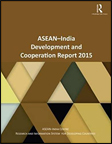 ASEAN-India Development and Cooperation Report 2015Re-engagement between India and ASEAN through increased cooperation across a range of issues, including trade and connectivity, is set to boost prosperity, competitiveness, growth and integration. With negotiations underway to establish a comprehensive free trade area through the Regional Comprehensive Economic Partnership, economic integration between India and Southeast and East Asia is set to scale new heights – further highlighting need for economic corridors with adequate cross-border infrastructure facilities that could facilitate increased production and services networks between ASEAN and Indian economies. This Report brings together experts and researchers who weigh in on ASEAN-India relations, analyzing the impact and implications of integration; assessing policy priorities, effectiveness, implementation imperatives and challenges; and discussing themes central to the economic sustainability of the region. Author: ASEAN–India Centre, Research and Information System for Developing Countries Year: 2015 Download Tags: ASEAN, India, Trade, Trade Facilitation Asian Development Outlook 2015 Supplement: Growth Holds Its Own in Developing AsiaThis Supplement maintains growth forecast for developing Asia at 5.8% in 2015 and 6.0% in 2016. In South Asia, economic outlook remains optimistic, with the region on track to meet Update projections of 6.9% in 2015 and 7.3% in 2016. India's economic expansion balances a slowdown in Bhutan—owing to weaker sales of hydropower—and the Maldives in 2015, and in Nepal in 2016—due to unfavorable weather and unforeseen delays in earthquake-related reconstruction. Growth projections for Bangladesh and Sri Lanka remain in line with those in the Asian Development Outlook Update. Author: Asian Development Bank Year: 2015 Download Tags: ADB, South Asia, Bangladesh, Bhutan, India, Maldives, Nepal, Sri Lanka 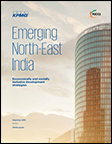 Emerging North-East India: Economically and Socially Inclusive Development StrategiesThis report highlights opportunities that can be explored in India's North East region, including tourism, energy, and infrastructure, to enable the North East to develop economically, while contributing to India's development as a whole. It takes stock of recent initiatives, including the 'Look East' Policy and the Bangladesh-Bhutan-India-Nepal (BBIN) subregional grouping, and identifies areas for improvement to propel inclusive growth. Harnessing the region's full potential would require upgrading the region's infrastructure. Significant investments are needed, since lack of connectivity and inadequate infrastructure present developmental bottlenecks, contributing to the slow pace of growth in the North East. The report presents policy recommendations and suggested actions, and a forecast for India for 2021-2022. Author: KPMG India and FICCI Year: 2015 Download Tags: India, BBIN, Connectivity, Transport, Trade Facilitation CPD Working Paper 110 – Trade and Transport Facilitation in Bangladesh: An Audit of the State of PlayThis publication provides a detailed picture of the status of specific measures for trade and transport facilitation in Bangladesh. It identifies measures already adopted, including strengthening of trade-related institutions, improvements in Customs processes and procedures, and reduction of non-trade barriers, highlighting areas for improvement and identifying existing gaps, to allow for proposals to meet these gaps. The audit undertaken aims to support policy-makers in Bangladesh in mobilizing the financial resources required to build a modern and efficient trade and transport facilitation system. Author: Mustafizur Rahman, Khaleda Akhter and Naimul Gani Saif Year: 2015 Download Tags: Trade Facilitation, Bangladesh, Customs Reducing Non-Tariff Barriers to Food Trade Between India and South Asia: Eliminating Phyto-Sanitary and Sanitary IssuesThis brief focuses on the impact of phyto-sanitary and sanitary measures as a significant non-tariff barrier to trade at India's overland trading posts and ports, from which it imports perishable goods from its neighbors in the SAARC region. Due to inadequate facilities to handle large, time-sensitive, and perishable consignments, India and its neighboring trade partners have experienced severe constraints on bilateral trade, which results to variability in time and cost of freight movement, and eventually affects price stability and availability of India's food stocks. Author: Hemant Shivakumar and Shiva C. Sharma Year: 2015 Download Tags: Sanitary and Phytosanitary Measures, India, SAARC, Trade, Non-Tariff Measures, Bangladesh Reforming Sri Lanka’s Trade and Investment Policies for Export GrowthThis Policy Insight examines four key areas of reform to increase Sri Lanka's competitiveness and promote external trade – trade tariff structure, trade and transport facilitation, promotion of foreign direct investment, and existing trade agreements with neighbors in South and Southeast Asia. It calls for a more transparent, simplified and rationalized tariff regime and adoption of measures to further strengthen trade and transport facilitation, including improvement of publication and administration of trade-related policies; increased usage of ICT for trade; and upgrading of trade-related infrastructure. Furthermore, it recommends pursuing beneficial trade agreements with neighbors, but with a more strategic approach in Sri Lanka's negotiations of trade agreements. Author: Institute of Policy Studies Sri Lanka Year: 2015 Download Tags: Sri Lanka, Trade, FDI 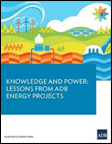 Knowledge and Power: Lessons from ADB Energy ProjectsThis publication highlights good practices and lessons learned from Asian Development Bank projects in energy, which comprised 26.5% of ADB's total lending commitments from 2008 to 2014. It discusses how the region's energy sources are utilized, providing updates on recent developments and challenges, highlighting the need for sustainable energy initiatives. Featured projects include the Green Power Development Project in Bhutan, which developed clean energy for regional use and promoted cross-border power trade. As the first infrastructure-focused public-private partnership in Bhutan, it also illustrated how projects can benefit with the active participation of the private sector, foreign parties, and commercial and public financial institutions. Also featured is the Bangladesh-India Electrical Grid Interconnection Project, which reduced Bangladesh's energy deficiency by enabling the country to affordably import 500 megawatts of electricity from India. This electrical link laid the groundwork for a regional energy market, an important step toward achieving a functioning regional electricity network in South Asia. Author: Asian Development Bank Year: 2015 Download Tags: Energy, Bangladesh, Bhutan, India, Regional Cooperation Doing Business 2016The World Bank's Doing Business 2016: Measuring Regulatory Quality and Efficiency reports that South Asia ranked second among regions, after Europe and Central Asia, in the largest share of economies implementing at least one reform to make doing business easier in the past year. 6 out of 8 economies in South Asia implemented a total of 9 reforms, including Bhutan, India - following the Government of India's ambitious program to increase ease of doing business launched in 2014 - and Sri Lanka. However, South Asia still lags behind in use of online systems in regulatory processes. The highest ranked economy in the region is Bhutan, with a global ranking of 71. Author: The World Bank Year: 2015 Download Tags: Business Efficiency, ICT, Bhutan, WB World Trade Report 2015The World Trade Report 2015 is the first major study to comprehensively examine the benefits and challenges of implementing the World Trade Organization's Trade Facilitation Agreement (TFA) since its adoption in 2014. It discusses the importance of implementation of the TFA, its economic impact, and the steps being taken by the WTO to enable countries to maximize its benefits. This report presents further evidence that speedy and extensive implementation of the TFA will lead to bigger gains, particularly for developing countries and least developed countries. Author: World Trade Organization Year: 2015 Download Tags: Trade, LDC, Trade Facilitation 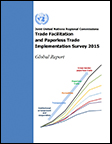 Joint UNRCs Trade Facilitation and Paperless Trade Implementation Survey 2015: Global ReportThis Report features results of the first UNRCs Joint Survey on Trade Facilitation and Paperless Trade Implementation, providing an overview of the current state of trade facilitation implementation in 119 economies across 8 regions worldwide. Though this Joint Survey finds that global average implementation rate of trade facilitation measures considered in the report stands at 52.9%, South Asia ranks below 40%. In the authorized operators and establishment and publication of average release times - categorized under the formalities measures - South Asia ranks below 10%. However, the region fares better in the institutional and cooperation measures, in particular with the recommendation to establish National Trade Facilitation Committees, with this measure most implemented in South Asia. The Report ranks India as the region's top performer in implementation of trade facilitation measures. Author: United Nations Regional Commission Year: 2015 Download Tags: Trade Facilitation, South Asia, Customs 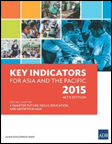 Key Indicators for Asia and the Pacific 2015The Key Indicators for Asia and the Pacific 2015 includes up-to-date available indicators for the 48 regional members of the Asian Development Bank, including numbers on energy, trade, transport, and tourism. Key trends noted in 2014 include the rising volume of intraregional exports globally, due to robust economic growth and expanding regional networks. For Asia and Pacific economies, primary source for merchandise imports was the region itself with a 49.7% share. In energy consumption, Asia and the Pacific now consumes more than 40% of the world's electricity, with the People's Republic of China and India accounting for nearly 70% of the region's output. This 46th edition of Key Indicators also includes a special chapter on skills, education, and growth in Asia, and emphasizes the need to focus on quality and ensure that the workforce has the skills to take the region through economic transition to prosperity. Author: Asian Development Bank Year: 2015 Download Tags: Economic Growth, Energy, Trade, Transport, India A Framework of Trade Policy for Bhutan: Compatible with the Gross National HappinessThis paper examines the compatibility between Bhutan's gross national happiness (GNH) index and trade policy, and attempts to contextualize Bhutan's trade policy issues - inclusive growth, trade facilitation, incidence of tariffs, and World Trade Organization accession. It explores trade and industry policy that is compatible with GNH guidelines, which aim to measure and improve people's holistic well-being: although it also includes factors that are seemingly unfavorable to an active trade policy. The report recommends benchmarking successful development strategies in other countries and creating an organization to pursue a more active trade policy to accomplish the urgent task of raising general living standards. Author: Inkyo Cheong, Taeho Bark, and Hoe Yun Jeong Year: 2015 Download Tags: Bhutan, WTO, Trade Policy, ADB Regional Transport Infrastructure: Mapping Projects to Bridge South Asia and Southeast AsiaThis Asian Development Bank (ADB) brief highlights the critical role of transport infrastructure in bridging South Asia and Southeast Asia. It maps details of economic corridors and highways, railroads, and seaports, and identifies priority transport investment projects needed to link the two subregions. While an investment of $986 million in road transport and $2.3 billion in sea ports may be needed to create proper connectivity between the two regions, the study's conservative estimate of potential benefit ranges from $89 billion to $358 billion over the next decade - demonstrating how investment in infrastructure can pay huge dividends in the medium- and longterm. Author: Peter Morgan, Mike Plummer, and Ganeshan Wignaraja Year: 2015 Download Tags: Transport, South Asia, Southeast Asia, ADB RCI Asian Development Outlook 2015 Update: Enabling Women, Energizing AsiaThis Update revises growth forecast for the Asia and the Pacific region down to 5.8% in 2015 and 6.0% in 2016, with delayed recovery in major industrial economies and slowing investment prospects in India and the People's Republic of China. Growth acceleration in South Asia has also been more modest than forecast - now projected at 6.9% in 2015, below the 7.2% March forecast, but up from 6.7% in 2014, and forecast to rise further to 7.3% in 2016. The need to energize growth in the region calls for avenues to unlock untapped resources, including narrowing gender gaps in the labor market. In Bangladesh, the increase in women's participation in the workforce has not only enhanced their bargaining power at home, but improved health and education options for the family. Author: Asian Development Bank Year: 2015 Download Tags: Asia-Pacific, Economic Growth, ADB Cross-Border Power Trading in South Asia: A Techno Economic RationaleSouth Asian countries have a wealth of diverse energy sources. These renewable resources, along with the varying electricity demand patterns among countries in South Asia, open up opportunities to share resources through electricity trading, which can be enabled by strengthening the electricity transmission system. This study examines the cost and benefit of six cross-border electricity transmission interconnections, and measures the economic and reliability benefits for participating countries in South Asia. Author: Priyantha Wijayatunga, D. Chattopadhyay and P. N. Fernando Year: 2015 Download Tags: Energy, SAARC, Regional Trade, ADB, ADB RCI Lessons for South Asia from the Industrial Cluster Development Experience of the Republic of KoreaGrowth of manufacturing is crucial for economic growth and poverty reduction. This report highlights the industrial cluster development policy of the Republic of Korea, including its success factors in terms of policy implementation, and the promotion of industrial cluster development, drawing lessons that could enhance industrial growth in South Asia. It discusses how the government encouraged increase in exports through relevant policies and adapted to more technology- and knowledge-intensive industries which required innovation-driven policies. The experience outlined in the report could benefit large-scale industrial promotion in South Asia, such as the Economic Corridor Program in India. Author: Jong-il Kim Year: 2015 Download Tags: South Asia, Industrialization, Economic Corridor, Trade, ADB, India, Bangladesh, Sri Lanka, ADB RCI Bangladesh-Bhutan-India-Nepal Motor Vehicles Agreement: Unlocking the Potential for Vibrant Regional Road Freight ConnectivityThe Bangladesh-Bhutan-India-Nepal Motor Vehicles Agreement (BBIN MVA) is expected to reduce trade transaction costs and be an effective tool to realize trade and investment potential in the subregion by generating new economic opportunities, particularly in the border areas. While it has put in place a good framework for facilitating transit and transport within BBIN, gaps remain in terms of interpretation and application of various procedures, and need for further policy harmonization among the contracting parties. This discussion paper analyzes operation issues and proposes solutions for cross-border movement of vehicles and Customs procedures. Author: Pritam Banerjee Year: 2015 Download Tags: BBIN, Trade Facilitation, Transport 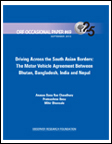 Driving Across the South Asian Borders: the Motor Vehicle Agreement between Bhutan, Bangladesh, India, and NepalThis paper discusses the benefits of strengthening physical connectivity in the Bangladesh-Bhutan-India-Nepal (BBIN) subregion through a Motor Vehicle Agreement (MVA). Through a framework that envisions transforming transport corridors into economic corridors and with its pipeline of 30 priority transport connectivity projects estimated at $8 billion, the MVA aims to increase intraregional trade in South Asia by almost 60%. This publication provides a concise background on the BBIN MVA, examining the circumstances leading to its signing, the role of the Asian Development Bank (ADB) and the ADB-supported SASEC Program initiative to enhance interconnectivity, challenges that require careful consideration, and its wider implications for the South Asian region. Author: Anasua Basu Ray Chaudhury, Pratnashree Basu, and Mihir Bhonsale Year: 2015 Download Tags: Transport, Trade Facilitation, BBIN World Trade Organization Annual Report 2015The World Trade Organization (WTO) Annual Report 2015 provides an overview of WTO activities in 2014 and early 2015. It presents a timeline of two decades of the WTO -- from its origins succeeding the General Agreement on Tariffs and Trade to its current role in the multilateral trading system. It presents a chapter on how WTO helps developing countries build trade capacity and allows them to implement trade agreements. WTO training courses are organized for officials from developing countries each year. Author: World Trade Organization Year: 2015 Download Tags: Trade, Trade Policy, WTO, Tariffs, Energy, Bangladesh, India, Nepal, Sri Lanka, Trade Facilitation, Transport, Asia, Agriculture 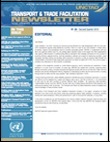 UNCTAD Transport and Trade Facilitation Newsletter No. 66 – Second Quarter 2015The Transport and Trade Facilitation Newsletter highlights trade facilitation support across countries and shares innovations from Cote d’Ivoire and Greece, including the new UNCTAD Technical Note on World Trade Organization (WTO) Trade Facilitation Agreement (TFA) ratification. It also features the meeting of the Global Facilitation Partnership for Transportation and Trade -- an event that brings together the private sector, WTO Member States and international organizations -- in a discussion to support TFA implementation. The Newsletter further shows United Nations Regional Commissions Global Survey on Trade Facilitation and Paperless Trade -- a response to the lack of comprehensive cross-country data and a guide to better understand and monitor trade facilitation implementation and paperless trade measures. Author: United Nations Conference on Trade and Development Year: 2015 Download Tags: Transport, Trade Facilitation, WTO, UNCTAD Building Firm-level Trade Competitiveness in Emerging EconomiesThis paper -- produced under the E15 Initiative and implemented jointly by the International Centre for Trade and Sustainable Development and World Economic Forum -- seeks to understand the framework of competitiveness and its implications for international trade. It discusses issues related to firm-level competitiveness, including the determinants; quality tools and models to address it, especially in developing economies and small and medium enterprises (SMEs); importance of diffusion and learning with a focus on SME growth; and specific policy interventions to improve firm-level competitiveness. Author: Sharmila Kantha Year: 2015 Download Tags: Firms, SME, Trade, Development, Sustainability, India, South Asia, Energy 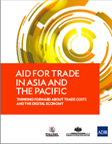 Aid for Trade in Asia and the Pacific: Thinking Forward About Trade Costs and the Digital EconomyAid for Trade (AfT) flows have increased each year since 2006 in Asia and the Pacific. While regional aggregate trade costs continue to fall, many subregions still struggle with trade costs that are substantially higher than the global average. This report highlights and explores how AfT contributed to these emerging trends in Asia and the Pacific and how to continue to address trade costs moving forward. Among the subregions, the Pacific (along with South Asia) has made the greatest improvements in the Logistics Performance Index from 2007-2014. Recent exporter surveys reveal a movement toward niche products and leveraging of e-commerce as a means to overcome cost and distance. Emerging digital technologies such as e-commerce further offers a new set of opportunities for economies in the region to grow through trade. Author: Asian Development Bank Year: 2015 Download Tags: Aid for Trade, Asia-Pacific, ICT, South Asia, Trade, Bangladesh, Bhutan, India, Sri Lanka, Agriculture, Energy, Transport  Maldives: Overcoming the Challenges of a Small Island State – Country Diagnostic StudyThe Maldives has propelled itself to middle-income status despite the geographic constraints and challenges of a small-island state. It has one of the lowest poverty rates in South Asia, although wide regional disparities in poverty rates and high-income inequality continue to be a concern. Growth – primarily driven by the tourism sector – has also been vulnerable to external shocks. As the Maldives moves toward a more sustainable and inclusive growth strategy, transport infrastructure is critical to help address the country’s connectivity issue and reduce the cost of doing business. This report identifies the critical constraints to inclusive growth in the Maldives and provides policy recommendations to sustain economic growth and hasten poverty reduction. Author: Asian Development Bank Year: 2015 Download Tags: Maldives, Small Island Developing States, Transport, Connectivity, Policy, Poverty Reduction, South Asia, Tourism SAARC: The Way AheadThis Observer Research Foundation Issue Brief examines the South Asia Association for Regional Cooperation as a regional grouping that is almost three decades old. It discusses trade arrangements such as the South Asian Preferential Trading Arrangement aimed towards a higher level of intraregional trade liberalization and economic cooperation, including the South Asia Free Trade Area for reduction of Customs duties on traded goods. The paper further studies areas of energy, connectivity, foreign direct investment, trade in services and subregional cooperation. The South Asia Subregional Economic Cooperation Program is offered as one of the steps in the direction of having a viable option for subregional cooperation. Author: Jayshree Sengupta Year: 2015 Download Tags: Regional Cooperation, SAARC, Trade, Connectivity, Energy, FDI, Investment, Free Trade Agreements, Services, South Asia UNRCs Trade Facilitation and Paperless Trade Implementation Survey 2015: Asia and the Pacific Report This report presents data on trade facilitation and paperless trade implementation from 44 economies across the Asia-Pacific region, covering 5 different subregions. It lays out key findings on implementation levels of general trade facilitation measures and ICT-based trade facilitation measures across the region, and provides empirical evidence for advancing trade facilitation. Findings suggest that there is still significant room for progress. In South Asia, regional average trade implementation comes a little above 40%. The report also noted that cross-border paperless trade facilitation is the least implemented of all groups of measures. Author: United Nations Economic and Social Commission for Asia and the Pacific Year: 2015 Download Tags: Trade Facilitation, Asia-Pacific, ICT 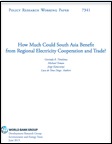 How Much Could South Asia Benefit from Regional Electricity Cooperation and Trade?This paper assesses the potential economic benefits of cross-border electricity cooperation and trade in South Asia from 2015 to 2040. It focuses on the possibilities of unlimited power flow across borders in response to regional demands and investment in generation and transmission to cost-effectively meet those demands. The study quantifies the potential economic benefits that South Asia could reap if the countries engage with full regional electricity trade and cooperation. Among South Asia Subregional Economic Cooperation countries, Bhutan and Nepal have the potential to cost-effectively supply electricity from hydroelectric resources in excess of their own demands; Bangladesh and India are likely to become more dependent on higher-cost coal as well as natural gas to generate electricity. The countries of the South Asia region also have non-coincident demand peaks across the year, implying gains from trade. Author: The World Bank Year: 2015 Download Tags: Energy, South Asia, Trade, Bangladesh, India, SASEC 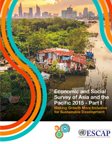 Economic and Social Survey of Asia and the Pacific 2015The 2015 edition of ESCAP’s Economic and Social Survey of Asia and the Pacific highlights inclusive growth as a prerequisite for meeting the Millennium Development Goals and critical for effective implementation of the sustainable development agenda post-2015. It also contains proposals to improve the pattern of public expenditures and increase access to financial services. Economic growth in South and South-West Asia increased in 2014, led by stronger macroeconomic performance in India, but remained far below its pre-crisis pace. While the near-term outlook is optimistic and conditional on continued domestic reform in large economies, limited intraregional trade within the sub-region could limit positive spillovers into relatively smaller economies. A key reform area is broadening the tax base and stemming of tax evasion to lower public borrowing and help address severe power shortages. Author: United Nations Economic and Social Commission for Asia and the Pacific Year: 2015 Download Tags: Asia-Pacific, Economic Growth, South Asia Asian Development Outlook 2015 Supplement: Growth Prospects Soften for Developing AsiaThis Supplement revises growth projections for developing Asia published in the Asian Development Outlook (ADO) 2015 in March, as slower-than-expected recovery in the United States and moderating growth in the People’s Republic of China weigh on the region’s prospects. Economic outlook for South Asia is stronger growth in the subregion as a whole in 2015 than forecast in ADO 2015, now bumped up slightly to 7.3% from 7.2%. The projection for 2016 remains the same at 7.6%. By individual countries, stronger growth is estimated for Bangladesh in FY2015, but slower growth is projected for the Maldives and earthquake-struck Nepal. Author: Asian Development Bank Year: 2015 Download Tags: Development, Economic Growth, South Asia Aid for Trade at a Glance 2015: Reducing Trade Costs for Inclusive, Sustainable Growth High trade costs inhibit trade integration in various developing countries, slowing growth and development prospects. This joint OECD/WTO publication emphasizes the Aid-for-Trade Initiative as an example of how to reduce trade costs and contribute to the emerging post-2015 development agenda. It calls for redoubling of efforts to tackle the issue of trade costs that continue to marginalize many of the world’s poorest and most fragile economies. The chapters highlight main achievements and challenges of the Aid-for-Trade Initiative. It further suggests a focus on reducing trade costs for an integrated approach in achieving inclusive and sustainable development outcomes. Author: World Trade Organization and Organisation for Economic Co-operation and Development Year: 2015 Download Tags: Aid for Trade, Trade Policy, WTO A Critical Disconnect: The Role of SAARC in Building the DRM Capacities of South Asian Countries This report evaluates the disaster risk management (DRM) efforts of the South Asian Association for Regional Cooperation (SAARC) in the last ten years as a regional organization, and assesses its impact in supporting the DRM national capacities of member states. Published after the April 2015 earthquake in Nepal, the publication underscores the critical role SAARC plays in building a common regional vision for DRM. It recommends focusing on priority activities that can assist member states in implementation of policies at a sub-national level; opening itself to support by external donors; and enhancing its training program through regional training of trainers by the SAARC Environment and Disaster Management Centre. Author: Stacey White Year: 2015 Download Tags: SAARC, Disaster Risk, South Asia WTO Dispute Settlement and Industrial PolicyThis paper explores the World Trade Organization's (WTO) dispute settlement mechanism in relation to the space it provides for Member countries’ industrial policies. It provides general conceptual reflections covering the role of WTO panels and the Appellate Body and the nature and categorization of WTO legal provisions applicable to trade in goods; and discusses how dispute settlement in WTO can affect or expand the policy space available to WTO Members in adopting industrial policy measures. This paper presents several examples that demonstrate the potential impact of WTO adjudicatory bodies on the policy space of WTO Members to implement and pursue industrial policy measures. Author: Jan Bohanes Year: 2015 Download Tags: WTO, Trade Facilitation, Policy Aid for Trade in Asia and the Pacific 2015This Asian Development Bank report explores the potential of the digital economy to improve the inclusiveness of Aid for Trade (AfT). It uses the review of AfT as a springboard to explore new ways of thinking and how to address issues such as high trade costs in some regions. In particular, it considers how to build on information and communications technology and infrastructure connectivity from established AfT spending. The report also highlights the experience of exporters to illustrate the unique challenges and opportunities for trade-driven growth in a region where high trade costs are structural. Author: Alisa Di Caprio and Kati Suominen Year: 2015 Download Tags: ICT, Infrastructure, Trade, ADB, Asia-Pacific, Exports, Economic Growth, Trade Facilitation Clean Energy and Access to Infrastructure: Implications for the Global Trade SystemThis paper focuses on how international trade rules could better accommodate renewable energy trade through fixed infrastructure. It explains the World Trade Organization disciplines relevant to trade in clean energy via fixed infrastructure, in particular General Agreement on Trade in Services disciplines on energy services and General Agreement on Tariffs and Trade transit rules. Finally, it suggests policy options to adopt existing rules to the challenges of integrating clean energy transported via fixed infrastructure. Author: International Centre for Trade and Sustainable Development Year: 2015 Download Tags: Energy, Trade, WTO, India, South Asia, Sustainability, Tariff Cross-Border Electricity Cooperation in South AsiaStrengthening cross-border electricity cooperation in South Asia can be part of the solution for providing adequate and reliable electricity. This World Bank Policy Research Working Paper reviews the status of cross-border electricity cooperation in South Asia, identifies key regional-level barriers to expand cross-border cooperation and trade in South Asia, and discusses the extent to which current domestic sector policies impede greater cross-border electricity cooperation. Finally, the findings offer policy recommendations on increased cross-border trade and cooperation. Author: Anoop Singh, Tooraj Jamasb, Rabindra Nepal, and Michael Toman Year: 2015 Download Tags: Energy, Regional Cooperation, Regional Trade, Bangladesh, Bhutan, India, Maldives, Nepal, South Asia, Sri Lanka, Trade, Trade Policy, WB Trade in Value Added: Concepts, Estimation and AnalysisThis Asia-Pacific Research and Training Network on Trade working paper aims to explain the concept of Trade in Value Added (TiVA), which could properly measure exports of an economy. It discusses how TiVA is measured and how it can help in a more comprehensive understanding of trade flows. It also explains global value chains and reviews current initiatives in constructing regional and international input-output tables, and estimates of TiVA involving Asia-Pacific economies. Author: Marko Javorsek and Ignacio Camacho Year: 2015 Download Tags: Asia-Pacific, Global Value Chains, Trade 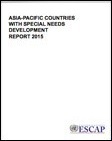 Asia-Pacific Countries with Special Needs Development Report 2015In the Asia-Pacific region, 36 out of the 58 economies are considered countries with special needs (CSN), which include least developed countries (LDC), landlocked developing countries, and small island developing States. This report highlights important areas that should be addressed as key priorities by CSNs such as economic diversification, external trade, South-South cooperation, and official development assistance including foreign direct investment. Bhutan and Nepal met the criteria for graduation from LDC status as of 2013. Other countries such as Bangladesh have a good chance of meeting the graduation criteria by 2018. Among the Small island developing States, Maldives is considered a success story in broadband internet connectivity. The results of this research show that Asia-Pacific CSNs must choose their paths to diversification carefully, depending on country circumstances. Author: United Nations Economic and Social Commission for Asia and the Pacific Year: 2015 Download Tags: Asia-Pacific, Least Developed Countries, Small Island Developing States, Bangladesh, Bhutan, Energy, FDI, Investment, Maldives, Nepal, Trade, Transport, UNESCAP Economic and Social Survey for Asia and the Pacific: Part 2 – Balancing the Three Dimensions of Sustainable Development: From Integration to Implementation This theme study outlines a conceptual framework, a set of strategies and policy options, and offers perspectives on institutional frameworks for integrating the three dimensions of sustainable development – economic growth, social progress and environmental protection. Regional cooperation is critical in maximizing opportunities for building synergies between the three dimensions. Initiatives at the regional level should consider establishing a regional road map, supporting regional economic integration initiatives, and strengthening regional platforms, including the United Nations and the multilateral system. Author: United Nations Economic and Social Commission for Asia and the Pacific Year: 2015 Download Tags: Asia-Pacific, Economic Integration, Regional Cooperation, Economic Growth, Environment, Sustainability, UNESCAP Outward FDI by Indian Manufacturing MNEs: Impacts and Implications This Asia-Pacific Research and Training Network on Trade Working Paper investigates the home country effects of outward foreign direct investment (OFDI) on domestic activity of Indian multinational enterprises (MNEs). The empirical evidence suggests that OFDI by Indian MNEs has a positive impact on export intensity and research and development. In order to derive desired complementary benefits of OFDI by manufacturing firms, policies may be directed to enhance the country’s international supply chain connectivity for greater participation in global value chain and production network. Author: Khanindra Ch. Das Year: 2015 Download Tags: India, FDI, Global Value Chains, Trade, Export, Development, Manufacturing, UNESCAP Trade and Non-Tariff Measures: Impacts in the Asia-Pacific Region This study brings together existing evidence on the occurrence and trade impacts of non-tariff measures (NTMs) in the Asia-Pacific region. It aims to contribute to an improved understanding on their trade impacts on developing countries. The report focuses on the consequences of NTMs for developing economies and South-South trade. The chapters include an overview of tariff and non-tariff measures, an evaluation of NTMs and trade, and an examination of Sanitary and Phytosanitary Measures and Technical Barriers to Trade. Finally, the study concludes by reviewing mechanisms for streamlining NTMs and promoting developing countries’ trade, particularly at the regional level. Author: United Nations Economic and Social Commission for Asia and the Pacific Year: 2015 Download Tags: Asia-Pacific, Tariff, Trade, Sanitary and Phytosanitary Measures, Technical Barriers to Trade, UNESCAP Together We Deliver 2014: From Knowledge and Partnerships to ResultsThis book includes stories from Bangladesh, India, and Nepal, introducing how ADB has changed people’s lives for the better. It illustrates the innovation and partnerships needed to meet the evolving challenges in Asia and the Pacific. In Bangladesh and India, two ADB projects introduced new approaches in urban governance and development that improved the living conditions of the poor in congested areas. In Nepal, women and other disadvantaged groups were included in the planning of a water and sanitation project that benefited 90,000 households. The 12 uplifting stories in this publication show how partnerships are essential for developing pragmatic solutions to problems, testing and refining approaches, and creating reliable models to scale up benefits for a wider base. Author: Asian Development Bank Year: 2015 Download Tags: Bangladesh, India, Nepal 2015 Annual Evaluation ReviewCountry assessments conducted by an independent evaluation team between CY2010-CY2014, and published in the the Asian Development Bank’s (ADB) 2015 Annual Evaluation Review, show relatively good performance of ADB operations in South Asia. Programs implemented in Bhutan and India, notably, reflected more developed institutional and organizational capacities in ADB sectors of engagement, alongside robust private sector involvement. Nepal and Sri Lanka programs, though affected by civil strife, were also rated successful. This report examines ADB operational performance in 2014, and includes evaluation recommendations. It aims to enhance ADB effectiveness by providing feedback on policies, strategies, operations, and special concerns in Asia and the Pacific. Author: Independent Evaluation Department Year: 2015 Download Tags: ADB, Evaluations, India, Bhutan 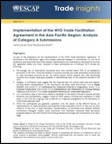 Implementation of the WTO Trade Facilitation Agreement in the Asia-Pacific Region: Analysis of Category A SubmissionsWorld Trade Organization (WTO) Trade Facilitation Agreement (TFA) provisions notified under Category A are those that WTO Member States have already implemented or have committed to implement by the time the Agreement enters into force or, in the case of the least-developed countries (LDCs), within a year of its entry into force. Provisions not included under this category are those which will require capacity building and technical assistance, or presumably take longer to implement. This trade insight paper analyzes Category A notifications of 15 economies in the Asia-Pacific region, contrasting the results with findings from an earlier ESCAP Survey on Implementation of Trade Facilitation and Paperless Trade (SITFAP) 2013/14 in order to examine some of the most challenging WTO TFA provisions, and gain insights on regional priorities for cooperation and capacity building. Author: Yann Duval and Pamela Bayona Year: 2015 Download Tags: Trade Facilitation, WTO, Least Developed Countries, UNESCAP Mega-regionals and the Regulation of Trade: Implications for Industrial PolicyThis report reviews key industrial policy issue areas being negotiated in mega-regional free-trade agreements—in particular, the Trans-Pacific Partnership—and evaluates how possible outcomes will impact the international trading system. Reviewing areas where the mega-regionals may impose systemic constraints, including border measures, technical barriers to trade, sanitary and phytosanitary measures, and e-commerce measures, the report discusses a possible future framework for industrial policy that integrates the additional policy constraints and changes introduced by these agreements. Author: Dan Ciuriak and Harsha V. Singh Year: 2015 Download Tags: Trade, Trade Facilitation, Free Trade Agreements Key Recommendations: South-Asia Consultation on the Post-2015 Development AgendaThe South Asian Association for Regional Cooperation, the United Nations Development Programme, the United Nations Economic and Social Commission for Asia and the Pacific, and the Asian Development Bank organized the South Asia Consultation on the Post-2015 Development Agenda in Nagarkot, Nepal on 26-28 August 2014. This Nagarkot Statement contains the eight guiding principles for future goals, key messages and recommendations on South Asia’s development priorities, financing for a post-2015 development agenda to support sustainable development, and technology access, including data, monitoring and accountability. Author: United Nations Economic and Social Commission for Asia and the Pacific Year: 2015 Download Tags: South Asia, Sustainability, ICT Connecting South Asia and South East Asia This book analyzes how closer regional connectivity and economic integration between South Asia and Southeast Asia can benefit both subregions. It aims to build a broad case for increased connectivity between the two regions and identify specific projects that have high potential to fulfill this objective. This joint study focuses on both “hard” infrastructure and associated “soft” infrastructure, including tariffs and non-tariff barriers, trade and transport facilitation, energy trading, and infrastructure investment and financing. It further provides a canvas for considering strategic cross-border infrastructure investments and policy reforms. Author: Asian Development Bank Institute and Asian Development Bank Year: 2015 Download Tags: South Asia, Southeast Asia, Connectivity, Economic Corridor, Transport, Trade Facilitation, Bangladesh, India, Sri Lanka Enabling Trade: Increasing the Potential of Trade Reforms This publication reviews specific elements of trade reform and proposes potential improvements that governments can make in collaboration with the private sector, using case examples to illustrate supply chain bottlenecks. It further examines how national governments and the private sector can optimize
ongoing trade reforms to reduce or eliminate these obstacles. Author: Bain and Company and the International Trade Centre Year: 2015 Download Tags: Trade, Private Sector, Trade Policy Asian Development Outlook 2015: Financing Asia’s Future GrowthThe Asian Development Outlook 2015 forecasts that the 6.3% rate of gross domestic product expansion achieved in 2014 will continue into 2015 and 2016. This is supported by a strengthening recovery in major industrial economies and soft global commodity prices. It also projects growth in South Asia to
accelerate to 7.2% in 2015, and 7.6% in 2016. Developing Asia needs a deep, robust financial sector to sustain growth, and policymakers are challenged to ensure inclusive financial sector development and financial stability to enhance growth and equity. Author: Asian Development Bank Year: 2015 Download Tags: Asia-Pacific, South Asia, Financial Sector Towards Trade Policy Analysis 2.0: From National Comparative Advantage to Firm-Level Trade DataThis paper argues for the need to upgrade current analytical tools for trade policy analysis and complement them with more detailed, firm-level data. Firm-level data allows a more refined assessment of future impact of trade policy initiatives, improves ex-post assessments, and enhances communication leading to a meaningful engagement with stakeholders, thus reducing public misperceptions about trade policy. A Trade Policy Analysis 2.0 could contribute to a better understanding of international trade for firm competitiveness, job creation, and consumer welfare. Author: Lucian Cernat Year: 2015 Download Tags: Trade Policy, Firms, Trade, ADB Policy Enablers for New Wind Energy MarketsThis publication focuses on the wind energy policies that can support sustained development of wind power in emerging wind energy markets. The policies are based on the work done by Quantum Leap in Wind Power Development in Asia and the Pacific (QLW). QLW is a $2 million, 3-year project funded by the Asian Development Bank, to facilitate wind power sector development in developing countries. The success and failures of wind energy policies in Mongolia, the Philippines, and Sri Lanka – including its impact and evolution – are analyzed in this report. Author: Pramod Jain and Bo An Year: 2015 Download Tags: Energy, Asia-Pacific, Sri Lanka, Sustainability, ADB 25 Years on the Ground: ADB-Nepal Partnership for Inclusive DevelopmentThis publication commemorates 25 years of Nepal Resident Mission’s opening and provides an overview of the Asian Development Bank’s (ADB) operation in Nepal over the years. It highlights ADB-assisted projects and Nepal’s association with the South Asia Subregional Economic Cooperation (SASEC) initiative, to further enhance the nation’s role in regional and world trade. These projects aim for regional energy cooperation (SASEC Power System Expansion Project), as well as subregional cooperation and connectivity in the transport sector (SASEC Road Connectivity Project and Subregional Transport Facilitation Project). Author: Asian Development Bank Year: 2015 Download Tags: Nepal, Transport, Energy, ADB RCI Nepali-language Version of Revised Kyoto ConventionThe Revised Kyoto Convention is a blueprint for Customs reform, and the Nepali-language version will assist Nepal’s Department of Customs to align its Customs Act and associated regulations with RKC standards, enhance efficiency and effectiveness of the Customs administration, and facilitate trade through more transparent Customs procedures. The standards of the RKC in the General Annex and Specific Annexes include duty collection, Customs control, information technology usage, and Customs clearance, among others. Author: World Customs Organization Year: 2015 Download Tags: Nepal, WCO, Customs Electricity Consumption, Output, and Trade in BhutanThis ADB South Asia Working Paper examines the relationship between electricity consumption, international trade, and economic growth using an augmented production function framework. The findings show that Bhutan is energy-dependent and can promote economic growth through future investment in hydropower. More specifically, the results show that a 1% increase in (i) electricity consumption generates 0.03%-0.05% increase in output, (ii) total trade results in 0.5% increase in output, (iii) trade openness results in 1% increase in output. Author: Hooi Hooi Lean and Russell Smyth Year: 2015 Download Tags: Energy, Trade, Bhutan, ADB, South Asia, Hydropower, ADB RCI |



